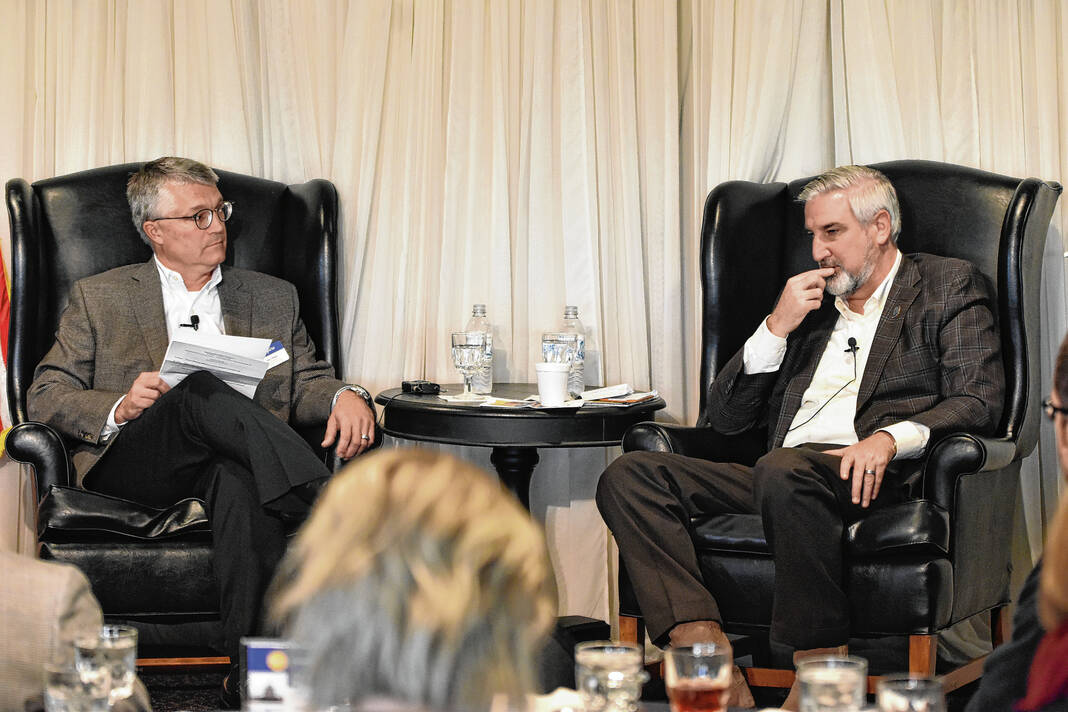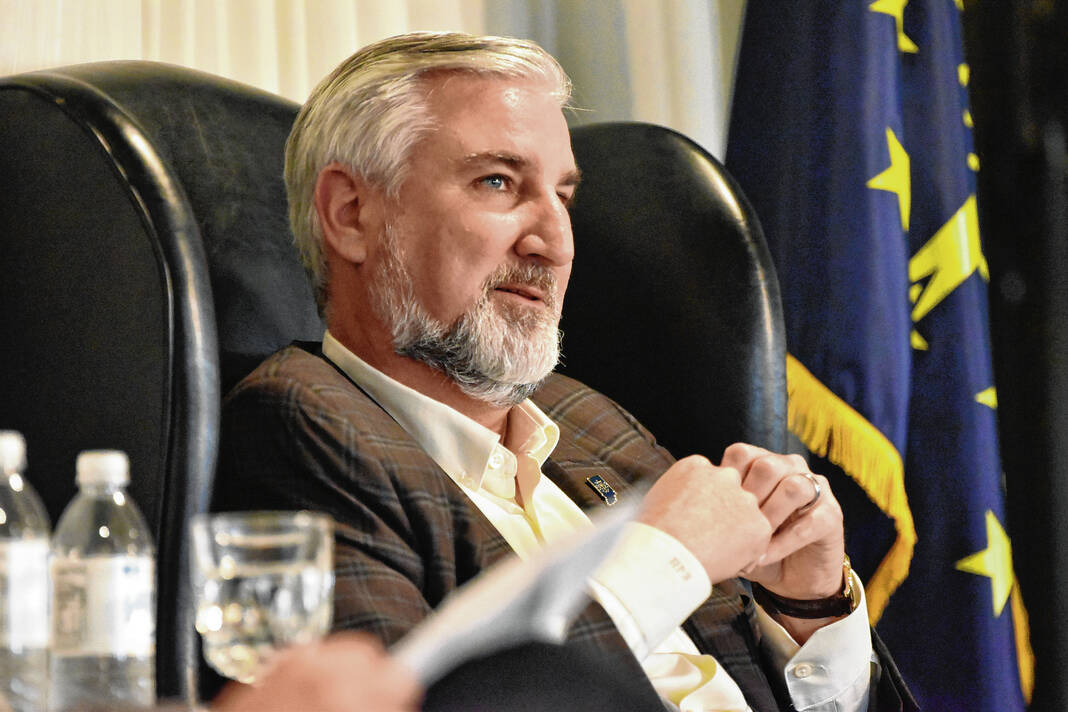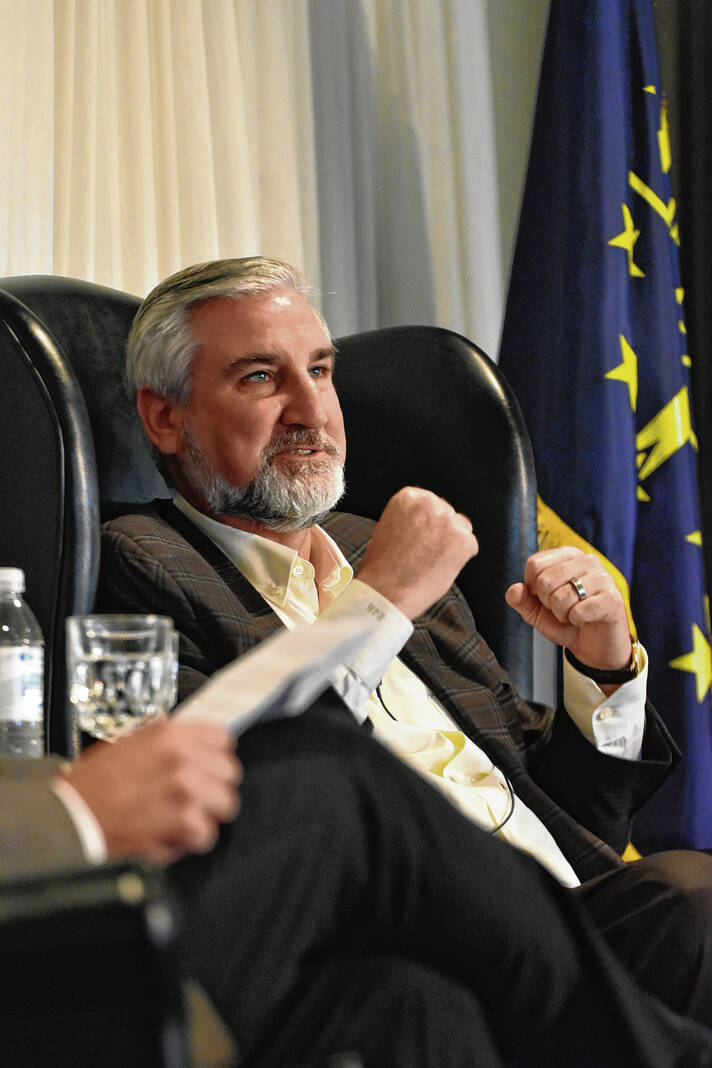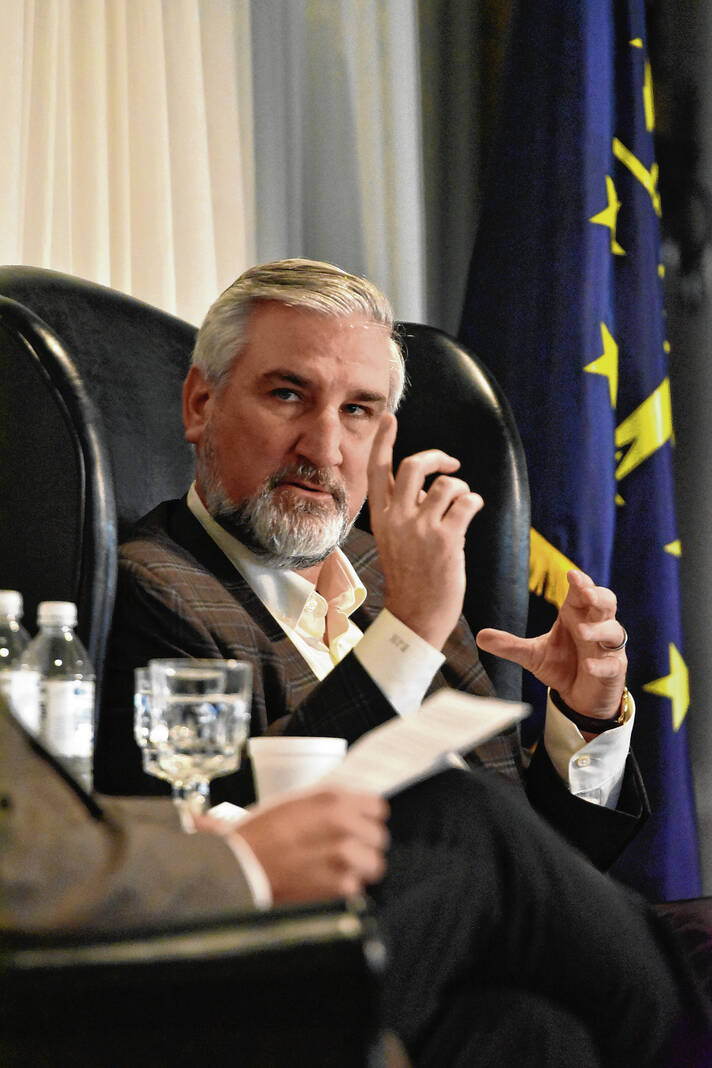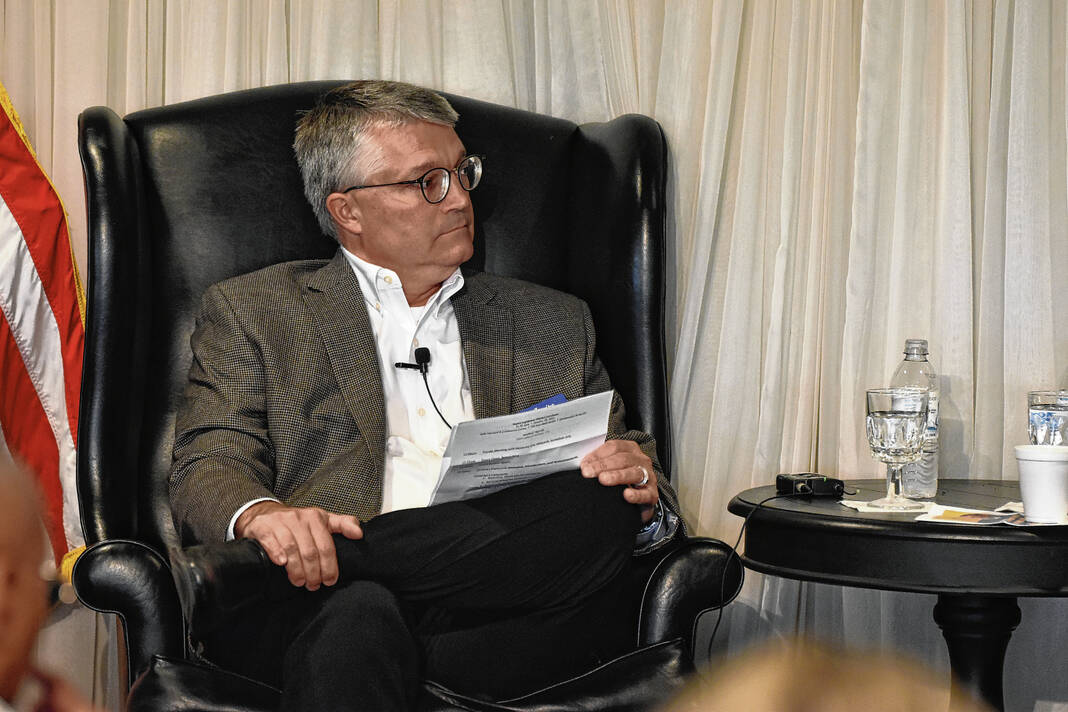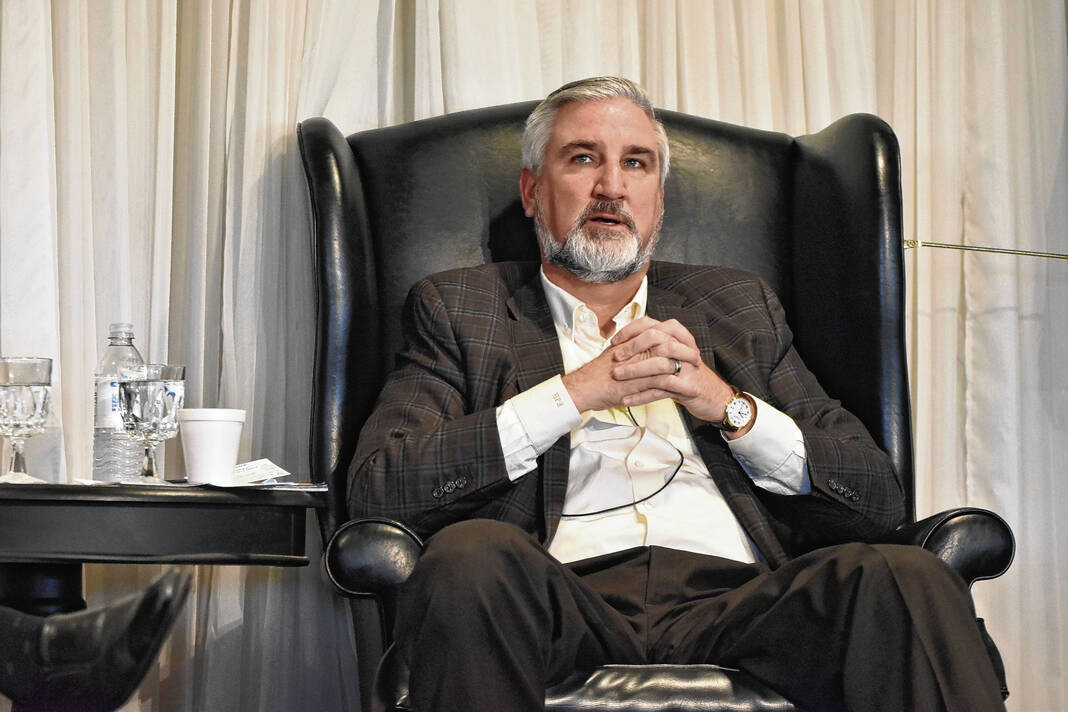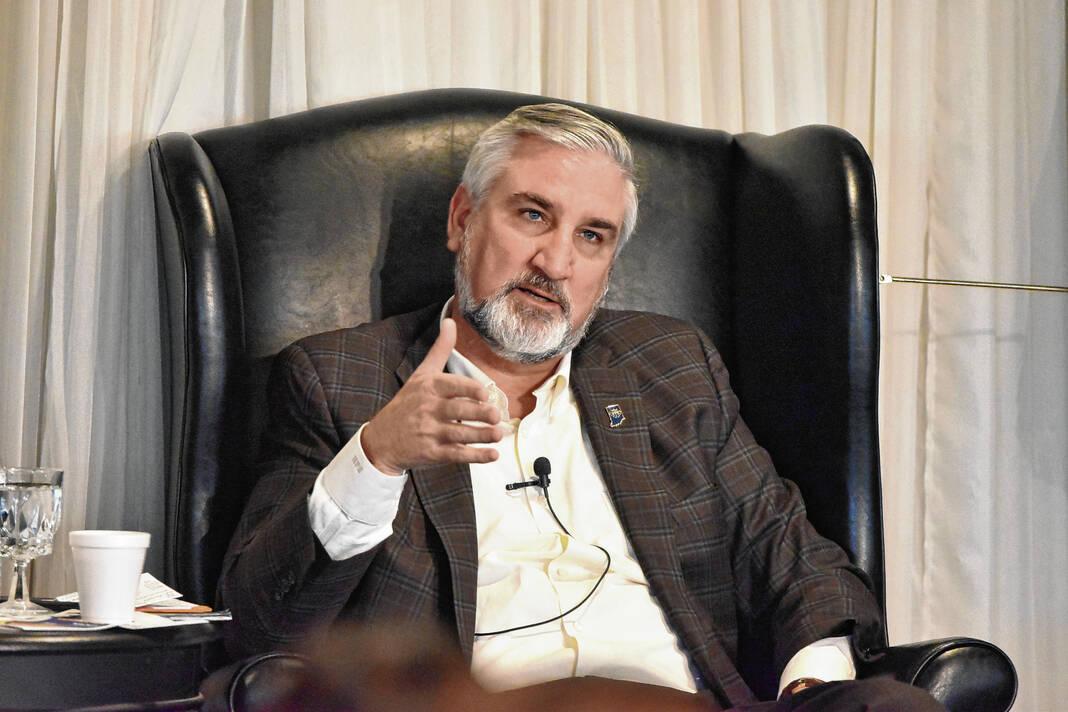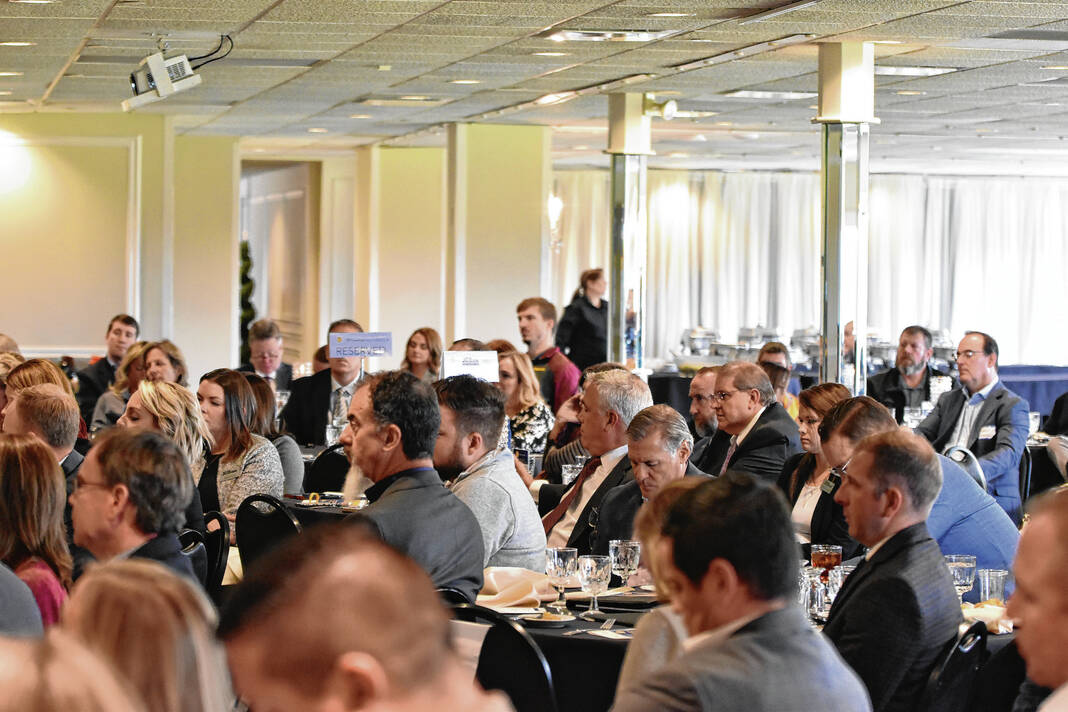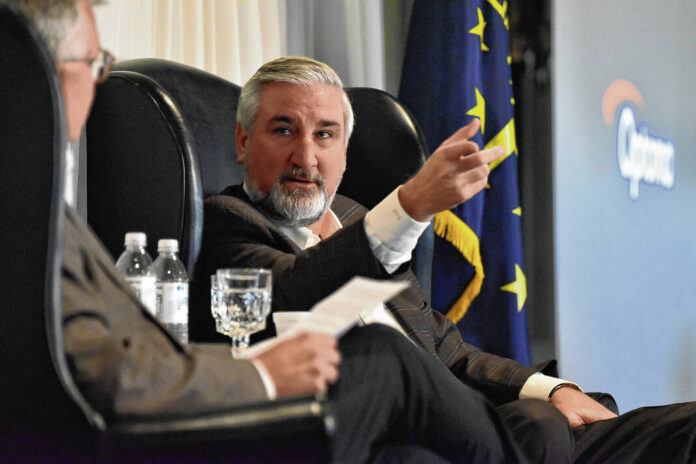
Gov. Eric Holcomb speaks as moderator Eric Prime listens during an Aspire Johnson County luncheon at Valle Vista Golf Club Tuesday in Greenwood.
Noah Crenshaw | Daily Journal
Gov. Eric Holcomb talked about economic development, talent attraction, his 2023 agenda and more during a special chamber luncheon Tuesday in Greenwood.
He was the featured guest at a special Aspire Johnson County Legislation Matters luncheon at Valle Vista Golf Club in Greenwood on Tuesday. He discussed economic development in a Q&A format with moderator Eric Prime, an attorney with Van Valer Law Firm.
2023 preview
Prime asked for glimpse ahead at Holcomb’s 2023 Next Level agenda.
Holcomb said he expects to roll the agenda out later than usual to see what the state’s revenue forecast is in December.
“We’re going into a very strong position now, but we’re paying attention to what’s going on around us and things we can and can’t control,” he said, referencing inflation.
Because next year is a budget year for the state legislature, Holcomb hopes to lock in funding for several priority issues before he leaves office. These include mental health, recommendations from the state’s public health commission, READI grants, workforce development programs and passing a balanced budget, he said.
He also hopes to give the Indiana Economic Development Corp. more tools to modernize the state to attract businesses.
International focus
Prime asked about Holcomb’s recent international forays.
That includes the state’s first-ever Global Economic Summit which took place in May. Over 800 guests, including some from Johnson County, and 30 international delegations attended, Prime said.
Holcomb told business leaders that the state’s economic traction didn’t start with the summit. The state has a rich history of being globally active and involved. The state started with this foundation to be intentional about being in the right rooms around the world to grow together, he said.
“I’m very selective and picky and we have the luxury of being in that position, but it is not by accident but on purpose and with a plan,” Holcomb said. “So that’s why we hosted that (summit) to talk about not just Indiana’s place in the future, but Indiana’s place in the world and our shared futures.”
These shared futures include mobility, energy, workforce development, workplaces and workers. The state has had a lot of good coming from the summit, though Holcomb did underestimate the power of side conversations that were occurring, he said.
“It was a diplomatic corps; it was a business corps,” Holcomb said. “… It was a cross-section of people who make decisions happen with decision makers from the Eastern to the Western Hemisphere. This was a very productive use of time and obviously capped off with the Indy 500, which is a very international race as well.”
Holcomb also discussed his recent international trips. In the last month, he’s been to South Korea, Taiwan, Switzerland and Germany on economic development trips.
Going on international trips serves as a reminder that there is no substitute for showing up, Holcomb said. Officials pay respect when they are on someone else’s soil and learn about their culture, he said.
Officials also learn about what other countries’ issues are and about shared challenges. For example, South Korean officials are just as concerned about their birth and death rates as U.S. officials are, he said.
“You learn these things and you’re able to (not just) try to hone in on problems or challenges, but solve them and typically you can solve them faster together,” Holcomb said.
READI and marketing the state
Holcomb was asked about the Regional Economic Acceleration and Development Initiative, or READI, grant, and how the state can leverage initiatives like this for economic development.
Holcomb said the READI program was about addressing population scarcity and talent recruitment because officials realize that people want to work where they want to live now more than ever, he said. The program helps communities craft plans that will help attract and retain residents, with things like quality of life projects, housing and talent attraction programs.
Holcomb said he’s planning a second phase of READI grants because the program can have a bigger impact on the state’s regions. The program works because priorities are coming from the local level and because it connects decision-makers at all levels, he said.
“What we’ve heard from some of these regions already is businesses are coming back saying that’s really helpful,” Holcomb said. “… I think that is the secret that most people don’t realize is we really do in Indiana … we have it all, but we have to share that story.”
Innovation is a big part of Indiana’s story, Holcomb said. To him, innovation is about making things better, faster, more efficient and cleaner. Indiana occupies a high ground in the middle of this, in terms of commerce, and is a huge asset, he said.
The state’s resources — including advanced manufacturing, energy sources and water abundance — are a credit to the state, along with higher education institutions like Indiana University, Purdue and Notre Dame, Holcomb said.
“We’re in that game and I think we’re winning,” he said.
Housing, workforce retention
Prime asked Holcomb about affordable housing and talent attraction.
Holcomb said housing, childcare and transportation are obvious areas for officials to continue to work on. Local governments and the federal government have been partners in helping the state build out its infrastructure, he said.
Addressing supply chain issues is an area that could help with infrastructure, he said. Access to concrete is an issue state officials are seeing. If officials were able to grow that sector, then it could address the supply chain issues, Holcomb said.
The supply chain is both an issue on the trade skill level and a product level. It’s a problem across multiple industries, he said.
“We’re having the same issues and so it’s the challenges of growth and managing growth,” Holcomb said. “… We’re a net exporter of a lot of these products, so how do we keep more for ourselves and really continue to make hay while the sun is shining?”
Holcomb predicts officials will be dealing with supply and demand issues for the foreseeable future. Increasing and skilling up the state’s workforce is part of this because talent is a demand issue, he said.
“We’re gonna try to run this forward, especially during this time of transition,” Holcomb said. “I do have a sense of urgency about me anyway because by law, I’m leaving a couple of years and so I better be able to look back and say we threw everything we have at it.”
Looking forward
Before he leaves office in 2024, Holcomb said he looks forward to seeing big infrastructure projects like Interstate 69, the North Split Project and the Double Track South Shoreline Project finally finished.
He wants to make sure the state is moving in the direction he wants with enough momentum, he said.
“Are we moving in the right front and then, demographically, where are we deficient?” Holcomb said. “Probably on my last day, I’ll be thinking … what kind of momentum do we have?”
During his time in office, he’s been inspired by the ingenuity and perseverance of Hoosier businesses. No matter the size of the business, their innovation is inspiring and helping the state tap its future potential.
“Truly our best days are ahead because we know what to focus on,” Holcomb said. “We are focusing on that community by community.”


